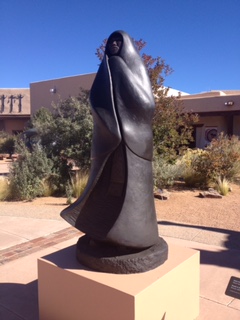 The quest for a place of Spirit and a community of sacred conversation is a hot topic among those with whom I talk these days. Denominations seem to be coming apart at the seams; old practices no longer have the power that they once did, and the thread of the question is “Where do I go to find an organic connection with the Holy and with people of similar longing?” Atchison Blue by Judith Valente tells one woman’s story of seeking and receiving answers to that question.
The quest for a place of Spirit and a community of sacred conversation is a hot topic among those with whom I talk these days. Denominations seem to be coming apart at the seams; old practices no longer have the power that they once did, and the thread of the question is “Where do I go to find an organic connection with the Holy and with people of similar longing?” Atchison Blue by Judith Valente tells one woman’s story of seeking and receiving answers to that question.
In this liminal time where Church is not what it has been, nor what it will be, it is the stories that keep us encouraged and hopeful. Valente’s story of awakening, even as she inhabits a place of being an “expert,” to the fact that she was parched and hungry in Spirit illuminates yet another facet of the search for a place for wonder, love and praise. The external challenges to her are sharp and baffling; she is newly married to a man with adult children who resent her presence. Her old practices of faith no longer support her current longings for connection to the Holy. And she has become aware of her own failure to exercise gentle behavior, which threatens her relationships, her work and her sense of being the person she is called to be. She finds in the Benedictine monastery of Mount St. Scholastica in Atchinson, Kansas, a sacred place with a sacred community who welcomes her into her search for practices that will re-shape her life.
The color, Atchison Blue, is winsome in itself. A specially created color for the monastery in 1947 by glassmaker Emil Frei, it has now been transformed by the elements into distinctive gray-blue that is not found any other places. For Valente it is an invitation to people such as herself as it washes over the chapel seats; it is not shiny and triumphant, but warm and comforting, allowing retreatants to take in the gift of beauty at their own pace. Its presence has a healing effect on every turn in her road.
The community of sisters is gentle and kind, while being truthful and prophetic. Their loving care that is poured out in stories, prayers and laughter, do as much to heal and to challenge the writer, as do the words of instructions and advice. The place–both geographical and theological–that this faith gathering has staked out makes it a safe, while challenging place for Valente to bring her questions and her wrestling. I am reminded that the way that for most of us leads to wholeness and ministry is through the kindness and constant prayers of another.
Valente’s candor about her own struggles is both refreshing and challenging in a time when the culture wants and expects us to put a good face on everything. Her honesty made me both glad and uncomfortable, wondering if it were pointing me to a more open look at my own journey. Her open-ended completion of that season with the community left us with knowing that although she had come far, the journey still lay before her, another reminder that the road goes ever on in the faith pilgrimage. The commitment to the order’s practice of conversio is a practice she takes with her, something she can practice wherever she is.
I am struck once again with the multitude of ways, times and styles of God’s seeking and finding us, whether or not we know we are looking. Valente’s narrative offers a perspective full of hope and promise.
From a greeting card, I have carried and prayed with this saying for many years: “If you’re going to be blue, be bright blue.” Valente’s bright blue shines as a gift for all of us.
For more conversation on Atchison Blue – and to read an excerpt – visit the Patheos Book Club here.











